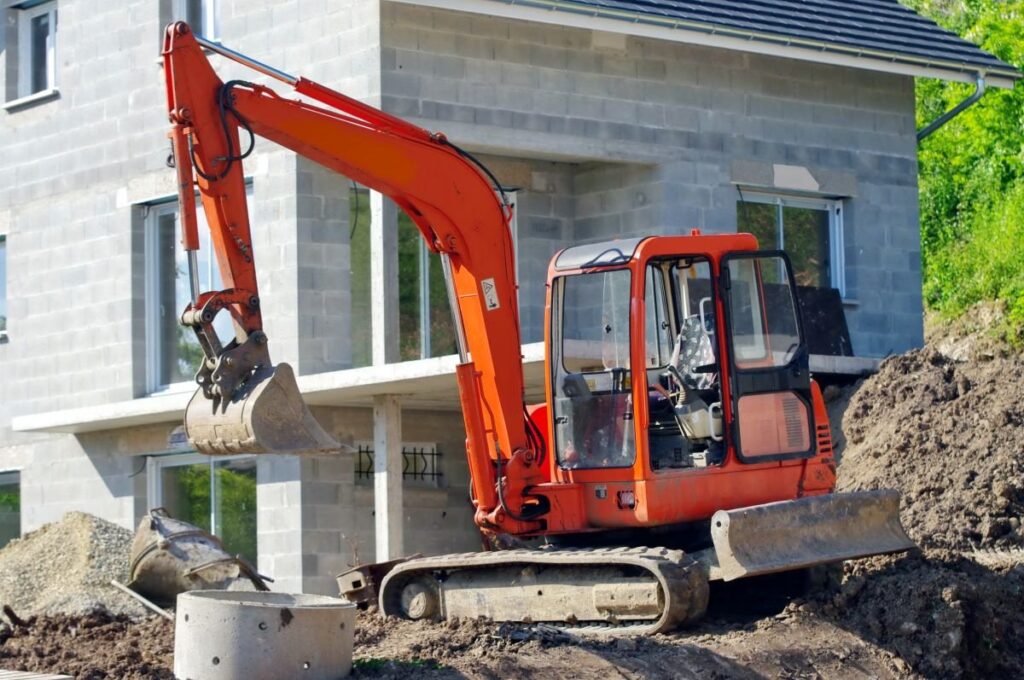On construction sites where deadlines are tight, and quality standards are high, you need to find a way to do more without exhausting yourself. You also need lightweight and maneuverable equipment that can pass through doors, move over rough terrain, and turn without damaging surrounding structures or equipment.
Mini excavators are often the ideal solution. They provide the power you need to get the job done efficiently while offering exceptional maneuverability.
Excavation Chanthier has prepared a complete guide to explain how to choose and use a mini excavator suited to your needs.
WHY RENT A MINI EXCAVATOR?
Among all types of excavators, the mini excavator holds a special place. Here are the three main reasons to rent one.
1. THE COST OF RENTING A MINI EXCAVATOR
To rent a mini excavator, expect to pay a minimum of $150 per day, excluding taxes. This price may vary depending on the chosen model, options, equipment, and accessories, as well as the power of the mini excavator.
Our excavation company in Quebec offers the rental of 1.7-ton mini excavators for various durations, ranging from a day to a month. We also offer to deliver the mini excavator directly to your construction site.
RENT A MINI EXCAVATOR
2. THE LIFESPAN OF A MINI EXCAVATOR
The average lifespan of a mini excavator is 10,000 hours. It is designed for tasks that are difficult to accomplish manually or are hard to reach, making it extremely versatile. Driving a mini excavator seems easy, but the user must be trained to operate the machine.
3. THE EQUIPMENT AND ACCESSORIES OF A MINI EXCAVATOR
One of the best aspects of a mini excavator is the ability to use it in different ways depending on the chosen accessories. With a quick coupler system, a mini excavator can also function as a breaker or hydraulic compactor in just a few minutes. Here are the main equipment and accessories for a mini excavator:
- Auger
- Trencher
- Hammer
- Grapple
- Plate compactor
- Angle blade
- Enhanced bucket option
- Rubber or steel tracks
HOW TO USE A MINI EXCAVATOR?
Using a mini excavator involves four essential maneuvers:
OPENING AND CLOSING THE BUCKET
For example, to dig a basement, you will need to operate the bucket located at one end of the excavator arm. This part will work the ground, so it is important to know how to handle it. Push the lever to the right to open the bucket and to the left to close it. To dig efficiently, position the bucket teeth perpendicular to the ground and gradually close the bucket as you lift it from the earth.
USING THE BOOM
To operate the boom, pull the lever toward you to raise the boom (the part of the articulated arm closest to the cab) and push it to lower it. The boom also allows for more efficient digging: use the boom’s power by lowering the arm to push the bucket deeper into the ground.
BRINGING IN OR EXTENDING THE STICK
This is the mechanical part just before the bucket that controls the arm articulation. It manages the inclination and range of the bucket. Simply push the left lever to bring the stick closer to you and pull it to extend it.
ROTATING THE TURRET
To rotate the cab on its axis, simply operate the lever located at the far left. This allows you to change your working axis without moving the tracks.
WHO CAN OPERATE A MINI EXCAVATOR?
No license is required to operate a mini excavator. However, it is strongly recommended training on the operation and handling of a mini excavator before starting to use one.
WHAT CRITERIA SHOULD YOU USE TO COMPARE MINI EXCAVATOR MODELS?
It is important to compare the specifications of all the mini excavator models you are considering to ensure you rent the equipment that best suits your needs and budget.
WHAT SIZE OF MINI EXCAVATOR SHOULD YOU CHOOSE?
The main selling points of mini excavators are their small size and lower cost in comparison with a full-sized excavator. When searching for mini excavators, you need to consider the dimensions and operating weight to ensure you can bring the equipment to your sites and perform the necessary work. Be aware of site obstacles and your towing capacity.
WHAT DIGGING DEPTH AND REACH SHOULD YOU PREFER?
Most mini excavators for sale offer a digging depth of between 7 and 12.5 feet. This figure represents the maximum depth achieved from a flat surface. We recommend choosing a machine with a capacity that is about 20% greater than what you typically need.
For example, if your projects require digging trenches 8 feet deep, you should choose a model with a maximum digging depth of at least 9.6 feet to reduce the need to reposition the equipment frequently.
The digging reach of a mini excavator typically ranges from 12 to 20 feet. The longer the reach, the less you will need to move and reposition the mini excavator on the site, saving you valuable time. For a longer reach, you can add a long arm option to some compatible mini excavator models.
WHAT POWER FOR THE MINI EXCAVATOR?
The power of a mini excavator should be considered once you have defined the criteria above. Once these are set, we recommend choosing the model with the highest available power.
CONTACT EXCAVATION CHANTHIER TO RENT A MINI EXCAVATOR SUITED TO YOUR NEEDS
Renting a mini excavator can be a good idea for your projects, especially if you don’t need to use it daily. There are many benefits, provided if you are accompanied by a professional.
The experts at Excavation Chanthier are ready to answer all your questions and guide you toward the mini excavator model best suited to your site.
Contact us today to discuss your project.


